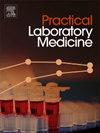Measurement of bilirubin in cerebrospinal fluid using the oxidase method on automated chemistry system advia XPT
IF 1.7
Q3 MEDICAL LABORATORY TECHNOLOGY
引用次数: 0
Abstract
Background and aim
Evaluate the diagnostic performance of automated, quantitative bilirubin measurement, modified to extend its lower measurement ranges, in cerebrospinal fluid (CSF) using the Siemens analyzer Advia XPT. Results were compared with the gold standard spectrophotometry for diagnosis of subarachnoid haemorrhage (SAH).
Method
Eighty clinical samples were analyzed on an Advia XPT, and results were compared to spectrophotometric results using the Agilent Cary 100 bio system. Method performance at low concentrations were evaluated using diluted control material and patient plasma and CSF samples. ROC curve analysis determined a suitable cutoff.
Result
Evaluation of low-concentration performance, below 2 μmol/L on Advia XPT, showed a measurement bias of -1.0 %, and a linear regression equation of y = 0.843x + 0.0351 (R2 of 0.975), describing the relationship between measured and expected concentrations of diluted samples. The coefficient of variation, (CV), was 2.92 % at 0.598 μmol/L and 26.6 % at 0.161 μmol/L. Using the outcome of the analysis on Agilent Cary 100 as reference, sensitivity was 100 % and specificity 96 %, employing a cutoff of 0.41 μmol/L.
Conclusion
Quantitative measurement of bilirubin in CSF using the bilirubin oxidase method on the automated Advia XPT platform perform well, with the analysis of low concentrations of bilirubin displaying a high precision and a high concordance with the results of spectrophotometry. These preliminary findings are indicative of the merits of quantitative measurement, that warrants further study of its diagnostic potential as an alternative to the more cumbersome spectrophotometry for diagnosing SAH.
自动化化学系统氧化酶法测定脑脊液中胆红素
背景和目的:利用西门子Advia XPT分析仪,评估脑脊液(CSF)中胆红素自动定量测量的诊断性能,改进后扩大了其较低的测量范围。结果与金标准分光光度法诊断蛛网膜下腔出血(SAH)进行比较。方法采用Advia XPT对80例临床样品进行分析,并与安捷伦Cary 100生物系统分光光度法结果进行比较。方法用稀释后的对照物和患者血浆及脑脊液样品评价低浓度下的检测效果。ROC曲线分析确定了合适的截止点。结果对Advia XPT在2 μmol/L以下的低浓度性能的评价偏差为- 1.0%,线性回归方程为y = 0.843x + 0.0351 (R2为0.975),描述了稀释后样品的实际浓度与期望浓度之间的关系。变异系数(CV)在0.598 μmol/L时为2.92%,在0.161 μmol/L时为26.6%。以Agilent Cary 100分析结果为参照,灵敏度为100%,特异度为96%,截止值为0.41 μmol/L。结论在Advia XPT自动化平台上应用胆红素氧化酶法定量测定CSF中胆红素,对低浓度胆红素的分析精度高,与分光光度法结果一致性高。这些初步发现表明了定量测量的优点,值得进一步研究其诊断潜力,以替代更繁琐的分光光度法诊断SAH。
本文章由计算机程序翻译,如有差异,请以英文原文为准。
求助全文
约1分钟内获得全文
求助全文
来源期刊

Practical Laboratory Medicine
Health Professions-Radiological and Ultrasound Technology
CiteScore
3.50
自引率
0.00%
发文量
40
审稿时长
7 weeks
期刊介绍:
Practical Laboratory Medicine is a high-quality, peer-reviewed, international open-access journal publishing original research, new methods and critical evaluations, case reports and short papers in the fields of clinical chemistry and laboratory medicine. The objective of the journal is to provide practical information of immediate relevance to workers in clinical laboratories. The primary scope of the journal covers clinical chemistry, hematology, molecular biology and genetics relevant to laboratory medicine, microbiology, immunology, therapeutic drug monitoring and toxicology, laboratory management and informatics. We welcome papers which describe critical evaluations of biomarkers and their role in the diagnosis and treatment of clinically significant disease, validation of commercial and in-house IVD methods, method comparisons, interference reports, the development of new reagents and reference materials, reference range studies and regulatory compliance reports. Manuscripts describing the development of new methods applicable to laboratory medicine (including point-of-care testing) are particularly encouraged, even if preliminary or small scale.
 求助内容:
求助内容: 应助结果提醒方式:
应助结果提醒方式:


